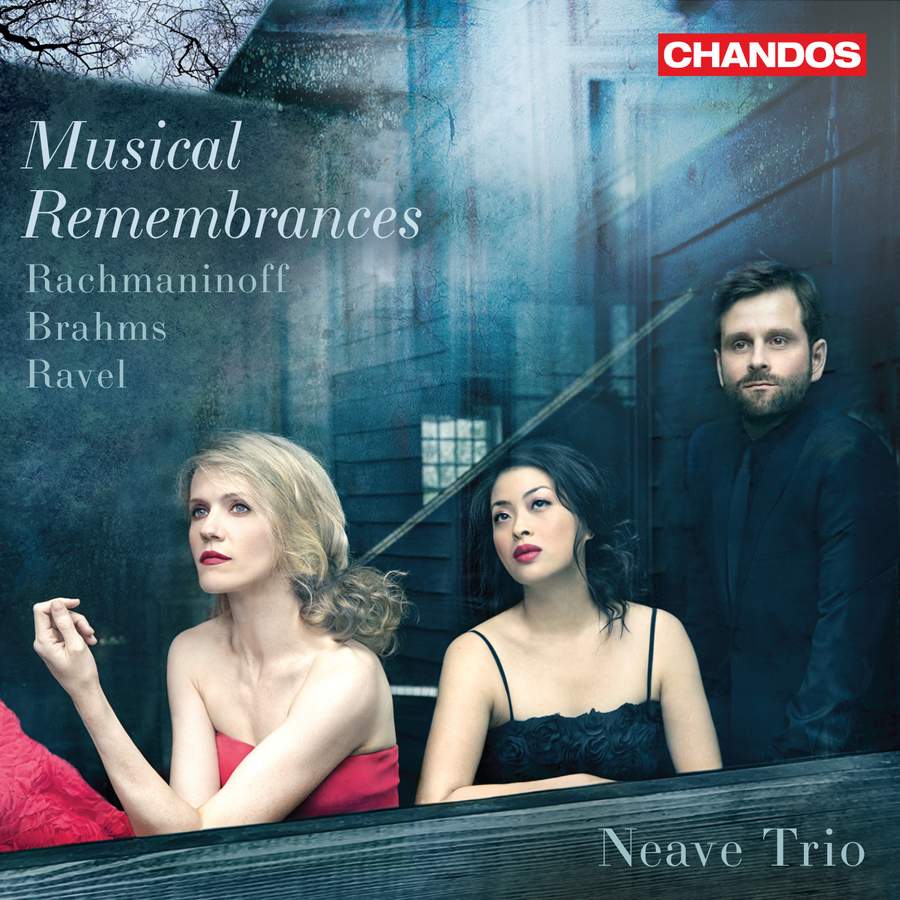Neave Trio: Musical Remembrances - Brahms; Rachmaninov; Ravel
View record and artist detailsRecord and Artist Details
Genre:
Chamber
Label: Chandos
Magazine Review Date: 07/2022
Media Format: CD or Download
Media Runtime: 77
Mastering:
DDD
Catalogue Number: CHAN20167

Tracks:
| Composition | Artist Credit |
|---|---|
| Trio élégiaque |
Sergey Rachmaninov, Composer
Neave Trio |
| Piano Trio No. 1 |
Johannes Brahms, Composer
Neave Trio |
| Piano Trio |
Maurice Ravel, Composer
Neave Trio |
Author: Harriet Smith
Some themes seem more alluring on paper than in reality, and the linking of three quite disparate sound worlds and styles under the banner of remembrance doesn’t necessarily make for the most natural of listening experiences. That said, if the performances are persuasive enough, such quibbles disappear.
The Neave Trio begin with Rachmaninov’s youthful Trio élégiaque No 1, and its opening sounds a little reined in: pianist Eri Nakamura could afford to be more forthright against the accompanying strings, who are nicely sweet-toned. But ‘nice’ doesn’t really cut it in a work of such swirling emotionalism, and while the Neave have a good sense of the ebb and flow of the Trio, they don’t reach the extremes of, for instance, Kremer, Dirvanauskaitė and Trifonov, who blend real urgency with imaginative flair. As Rachmaninov stills the momentum in the closing bars, the strings con sordino, the Neave are less shattering (and shattered) than in the Kremer account.
They present Brahms’s First Piano Trio in its revised version of 1889, but here the competition is even hotter than in the Rachmaninov. There’s an unhurried quality to the first movement, cellist Mikhail Veselov eager to make the most of the beauty of his unfolding melody, with violinist Anna Williams joining in a gentle duet. I much like their tempo for the Scherzo, which sounds duly effortless, but the pay-off is a lack of fury as the tone hots up (Vogt and the Tetzlaff siblings are terrifying here), while in the B major Trio they don’t find the same degree of serenity as Pires, Dumay and Wang. But the real issue in this reading is the Neave’s Adagio, which is dangerously slow – as slow as Pires et al but with none of their sense of line; Vogt and friends go for a more easeful, natural-sounding tempo here. The Neave’s finale is an easier listen, tempo-wise, but others find a greater degree of edginess and dare to do more with Brahms’s hushed dynamics.
It’s a similar story in the Ravel: while the dreamlike, veiled qualities of the opening movement are relatively effective, the more vehement writing tends to be a tad polite and there isn’t that sense of journeying from movement into stillness that groups such as the Capuçon brothers and Frank Braley conjure so potently. The second-movement ‘Pantoum’ is unquestionably pristine in finish but somewhat underwhelming emotionally, the climax at 1'36" a pale affair compared to the Capuçon/Braley reading. As in the Brahms, they’re tempted to take the slow movement, the famous Passacaille, too spaciously. And again, it’s less to do with tempo than line. Whereas Braley imparts a sense of majesty and inwardness as he reveals the passacaglia theme, Nakamura’s approach is relatively plain and you’re much more aware of the bar lines. Matters improve in the Animé finale, with some fine filigree playing on display, but the dramatic, trumpet-infused idea is relatively undercharacterised, and mere moments with Capuçon/Braley sweep you into a much more vivid world.
The Neave are, however, beautifully captured by Chandos’s recording team, and Stephen Johnson contributes typically classy notes.
Discover the world's largest classical music catalogue with Presto Music.

Gramophone Digital Club
- Digital Edition
- Digital Archive
- Reviews Database
- Full website access
From £8.75 / month
Subscribe
Gramophone Full Club
- Print Edition
- Digital Edition
- Digital Archive
- Reviews Database
- Full website access
From £11.00 / month
Subscribe
If you are a library, university or other organisation that would be interested in an institutional subscription to Gramophone please click here for further information.




